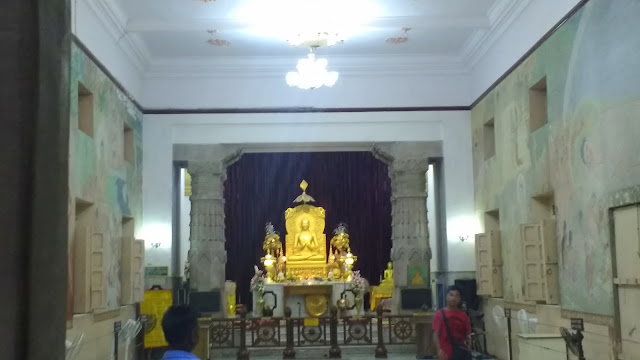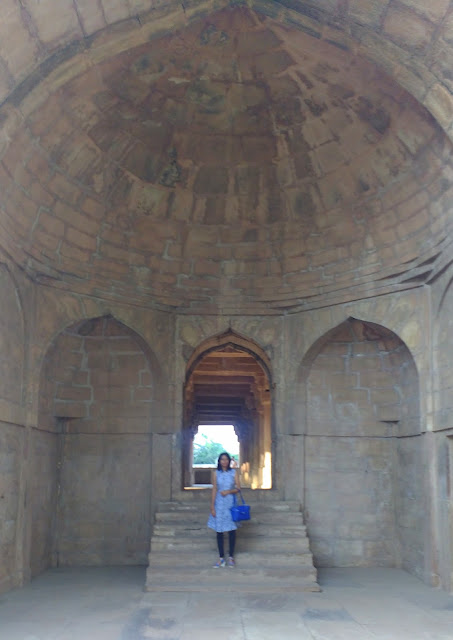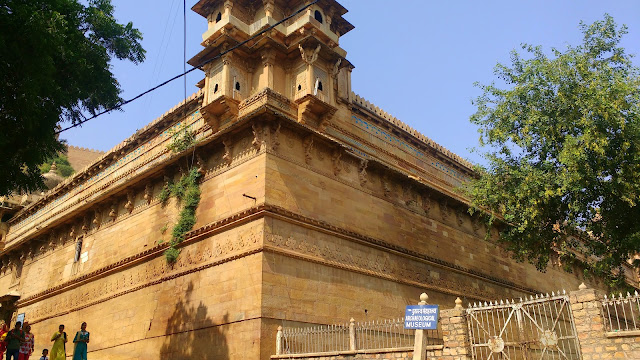14-Oct-17 Saturday 8 Varanasi
Morning boat rides to arati [ Assi ghat : Rs 400 ] ,evening
arati [200] and walk tour [Rs 600]
Varanasi
By foot is
the only way to see the waterfront and the ghats - but be ready to be hot,
sweaty, and lost - locals are usually happy to point you in the right
direction. The names of ghats and signs pointing to restaurants and hotels are
often painted on the walls in Roman letters. For better orientation, walk into
any book store and pick up a small guide/map book that will have the list of
all the ghats and their historical background.
Walking Tours are
operated by many companies, with the cheapest being the daily tours operated by Stops Hostel (₹100 plus
transportation, 3 hours). Walking tours are a great way to see some of the
harder-to-find sights such as the Flower Market and Ayurvedic Herb Market.
By cycle-rickshaw and
auto-rickshaw
The chaotic streets of Varanasi are sometimes too much to handle by
foot. Therefore, it will often be convenient to travel by cycle rickshaw or
auto-rickshaw. A short journey of a few kilometers should cost under ₹50, while
a longer journey within the city, such as between the ghats and the train
station, will cost ₹100. Further journeys, such as to Sarnath (10km), cost ₹200 each way by auto-rickshaw. If you take a
"Shared rickshaw" you can get everywhere for ₹20, be patient and
insist on wanting a shared one.
There is a pre-paid auto-rickshaw stand at the Varanasi Junction (Cantt)
train station.
By Maharaja Rickshaw
The city also has Maharaja Rickshaw(or Mr Rickshaw Wala) run by a new
company which offers tailored luxury experience at very low price(starting
INR250 per person). This creates all together a different experience of seeing
city and also the drivers are very friendly.
Some of the most popular ghats, from north to south:
Panchganga Ghat -
the meeting of the five rivers
Manikarnika Ghat -
the main cremation ghat; a must-see, but remain quiet and never take
photographs (note: scams are plentiful here; see the "Staying Safe"
section)
Dasaswamedh Ghat -
known as the 'main' ghat, this is the site of the large evening aarti ceremony
Rana Ghat
Kedar Ghat -
brightly painted in stripes and busy with bathers, very photogenic
Narad Ghat -
the ghat on which bathing with spouse is not advised because the legend of
contention
Harishchandra Ghat -
the cremation place where Raja Harishchandra did the last rituals of his son.
Hanuman Ghat
Shivala Ghat
Tulsi Ghat -
site of the large water purification plant
Assi Ghat - a
popular place to stay, with many hotels, restaurants, and internet cafes
Watch Indians bathing in the Ganges -
Over 60,000 people come to the ghats every day to take a dip in the sacred
waters of the Ganga, most notably at sunrise. This is a fantastic sight to see.
However, due to the sewage pipes that discharge feces into the river, along
with sunken corpses, there is a risk of infection from numerous diseases such
as hepatitis and bacteria such as e-coli. Reports have shown that the Ganges
water has a fecal coliform MPN of 88,000 per 100ml, compared to a desirable
fecal coliform MPN of 500 per 100ml.
Boat rides -
Very popular, especially at sunrise and sunset. Boats can either be rowboats or
motorboats. The most popular sunset ride is to start at Dasaswamedh Ghat or one
of the many ghats along the river and head up to Manikarnika Ghat to see the
cremations, then down to Dasaswamedh just after sunset to watch the
evening aarti ceremony from the boat. Sunrise is another
magical time for a ride, when the ghats are filled with Hindus bathing and
starting their day - one of the most famous sights in India. You can bargain
the price of the boat ride to around ₹50/person per hour. During the boat ride,
other boats, usually manned by children, will float up to your boat to sell
bowls with flowers and a candle to be offered to the river (₹10) or masala chai
(₹10), or various trinkets that are overpriced. It is recommended to avoid
polluting the river further by 'offering' non-biodegradable objects to the
river. At Nishadraj Ghat, a few minutes walk from Assi Ghat, you can find a
boat driver named Bhomi, a local singer renowned for his incredible voice and
charming, beautiful songs; during the boat ride he sings anything from local
folk songs to modern film songs and old devotional ones, and often improvises
lyrics over his own songs to communicate with you and the various people
gathered on the ghats.
Explore the alleyways -
The sounds, sight and smells are just unbelievable! Walk along the ghats and up
to the sights.
Alamagir Mosque, (overlooking Panchganga Ghat). a great place for a
bird's eye view of the area. edit
Durga Temple. edit
Gauri Matha Temple. The devi at this temple is supposed to be the
sister of the lord Kashi Vishwanath. Its a tradition to visit here just before
you leave Kashi. You buy sea shells at this place and offer them to God saying
that the virtues of donating the shells goes to her while you keep the virtues
of having visited the holy shrines in Kashi and bathing in the ganga. The trip
to Kashi is expected to yield results only after completing this
custom. edit
Kaal Bhairav Temple. Dedicated to Kaal Bhairav, a dreaded form of
the Lord in Shiva avatar symbolizing death. Its a tradition to buy a black
thread (Rs. 15), sanctify it in the shrine, then wear it on the arm, wrist or
around the neck as protection against evil. edit
Nepali Hindu Temple, (near Lalita Ghat). A small golden temple,
built in Nepali architecture edit
Shri Kashi Vishwanth Temple (Golden Temple), [1]. Security is tight making
entrance difficult and sometimes completely off limits to foreigners. No bags,
cellphones or pens are allowed. They can be deposited in the shops by the
temple entrance. The temple was destroyed multiple times by Mughal invaders and
was re-constructed by Hindu kings who followed them. edit
Sankat Mochan Temple. The famous Hanuman temple, home to thousands
of monkeys. Security is tight, mobile phones, keys etc. are not allowed inside
the temple as a result of moslem terrorist bomb blasts; and as you enter you
will be greeted by the sight of hundreds of monkeys on the premises. Beware-
they may snatch from you if they see you carrying boxes or packets of food. Inside
the temple you will find stacks of hanuman chalisa text for the use of
devotees. edit
Tulsi Manas Temple.
Banarasi Khana, or local delicacies, are known for their flavors. Many
dishes here are flavored with asafoetida, ginger, bay leaves, cloves, cardamom,
cinnamon, and/or dried fenugreek leaves.
Benares Dum Aloo is different from the dum aloo cooked elsewhere in
India because the potatoes are stuffed with and cooked in a gravy that includes
jaggery, fennel, and chili paste.
Varanasi is also known for its street food and chaat vendors. Aloo
chaat is very common.
Varanasi Paan is famous all over India and the world. Paan is an
assortment of flavors wrapped in a betel leaf. There are two versions: One that
includes tobacco, and one that includes only sweet flavors. The exact ingredients
depend on how much you offer, which can be as little as ₹10 or as much as ₹300.
To eat the sweet version, shove the entire leaf in your mouth at once and chew
until you swallow!
Rabri Malai Balai is a popular dessert in Varanasi that includes
milk, sugar, almonds, and pistachio nuts. You can find it served in
hole-in-the-wall or sweet shops.
There are plenty of food outlets with a very dynamic range in quality.
The restaurants closer to the ghats cater more to foreign tourists, with
variable success.
Keshav Tambool Bhandaar: (near
B.H.U.,Ravidas Gate) Paan with natural ingredients.
Shiv Lassi Bhandar: (near
the main gate of RamNagar Fort) Lassi with layers of Malai and Rabri. Superb
Stuff.
Kashi Chat Center: (near
Godowlia Crossing) Good assortment of exotic chats. Try out the Aloo Tikia
Chat.
Madhur Jalpan:The best
place for laddoos and other famous sweet delicacies is 'Madhur Jalpan', a shop
that has been frequented by more than two prime ministers of India! Madhur
Jalpan is on Baradev - next to the Kainiya Chitra Mandir (now Spice KCM).
Again, on a small alleyway, but the sweets are to die for.
Sarnath (10km
from Varanasi) -
It is believed that in Sarnath Buddha gave his first sermon to
his disciples after getting enlightenment. There is also a Museum in Sarnath.
The location is also known as Deer Park. Sarnath is 13 Km from Varanasi and is
very peaceful. Several Asian countries have built Buddhist temples there
following their own ancient architectural traditions.
15-Oct-17 Sunday 9 Train
Morning Aarti at Assi ghat [Boting:400]
I would suggest you take a walk towards assi ghat in the
morning , a good 30 min one way walk to view aarti.Walk along the ghats in the
morning is something special.


























































































